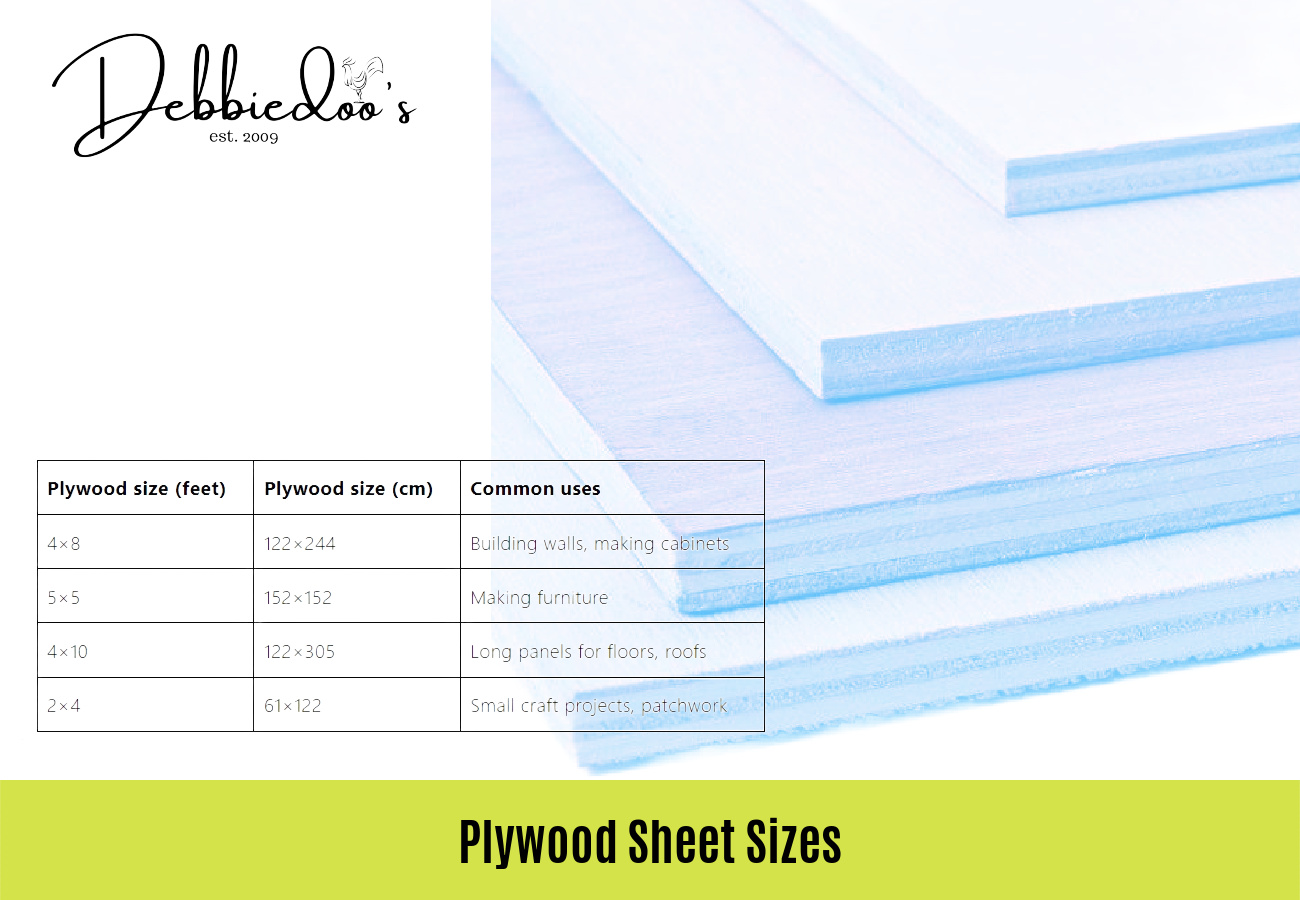Plywood is made by gluing thin layers of wood together and comes in various sizes. It’s practical for various construction projects, from building house parts to making furniture. This article takes a look at the different dimensions of plywood you can find, including thickness, and why you might choose one size over another.

Plywood sizes chart
| Plywood size (feet) | Plywood size (cm) | Common uses |
| 4×8 | 122×244 | Building walls, making cabinets |
| 5×5 | 152×152 | Making furniture |
| 4×10 | 122×305 | Long panels for floors, roofs |
| 2×4 | 61×122 | Small craft projects, patchwork |
Plywood thickness chart
| Nominal plywood thickness (inch or mm) | Actual plywood thickness (inch or mm) | Common uses |
| ⅛ or 3.2 | 3/32 or 2.38 | Crafts, model building, back panels of cabinets and drawers |
| ¼ or 6.4 | 7/32 or 5.56 | Panels, furniture, shelves |
| ½ or 13 | 15/32 or 12 | Subfloors, roofing, walls, sturdy furniture |
| ¾ or 19 | 23/32 or 18 | Decks, floors, countertops, shelves, storage units |
Standard plywood sheet size
A sheet of plywood is usually rectangular, measuring 4×8 feet (122×244 cm). It’s about the size of a large rug, ideal for most building projects. These dimensions are easy to cut and transport.
Larger plywood sheets are available, such as 4×10 feet (122×305 cm) or 5×5 feet (152×152 cm) with a square shape. There are also small sizes, such as 2×4 feet (61×122 cm).
Many home improvement stores have precut plywood panels at standard sizes, depending on the store. It’s also possible to order custom-sized plywood sheets that perfectly fit your project, either at the store directly or online, although they’re usually more expensive.
Nominal and actual plywood thickness
The nominal thickness of most plywood sheets is between ⅛ inch or 3.2 mm (three pennies stacked together) and ¾ inch or 19 mm (a pencil). “Nominal” refers to the thickness it’s sold at.
The actual thickness of plywood is slightly less than the nominal due to sanding after the sheets have been glued together. For instance, a nominal thickness of ½ inch (13 mm) may equal an actual thickness of 15/32 inch (12 mm). Similarly, a ¾ inch (19 mm) nominal thickness might be closer to 23/32 inch (18 mm) in actual thickness.
The difference between nominal and actual plywood thickness might seem confusing to those inexperienced. You might feel a bit cheated, as if the store isn’t giving you what you paid for, given the mismatch between the advertised measurements and the ones you’ve taken yourself. But it’s completely normal.
What plywood sheet size do I need for my project?
- 4×8 feet (122×244 cm) plywood sheets are very popular due to their versatility. They can be used in various projects, from building walls to making cabinets.
- 5×5 feet (152×152 cm) plywood sheets are often used for making furniture since they provide a larger surface to work with.
- 4×10 feet (122×305 cm) plywood sheets are ideal for projects that need long panels, like floors or roofs.
- Smaller sizes, like 2×4 feet (61×122 cm), can be used for small craft projects or patchwork.
What plywood sheet thickness do I need for my project?
- ⅛ inch (3.2 mm) is suitable for small, lightweight projects like craft activities or model building. It’s also often used for the back panels of cabinets and drawers.
- ¼ inch (6.4 mm) is handy for making panels, furniture, or shelves that don’t need to carry a lot of weight. It can also be used to cover rougher, heavier plywood or an existing surface for a clean finish.
- ½ inch (13 mm) is great for bigger projects around the house, like building the layer under the floors, roofing, or walls. You can also use it to make sturdy furniture like cabinets or boxes.
- ¾ inch (19 mm) is necessary for projects that need strength and durability, like building decks, floors, and countertops. This thickness can also be used to make shelves and storage units that must bear a lot of weight.
These measurements are for nominal thickness, not actual. The plywood sheet size thickness you need depends on several aspects, like appearance preferences, weight support, and indoor or outdoor use.
How to cut plywood to size
- Use a table saw, circular saw, or hand saw.
- Take all safety precautions, like wearing protective gear and securing the plywood before cutting.
- Start by measuring the desired size, marking it out on the plywood sheet. Then, using a straight edge, draw the cut line.
- Double-check to set the blade to the correct depth – just slightly deeper than the plywood thickness.
- Finally, follow the line and make the cut, keeping your hands clear of the blade.

